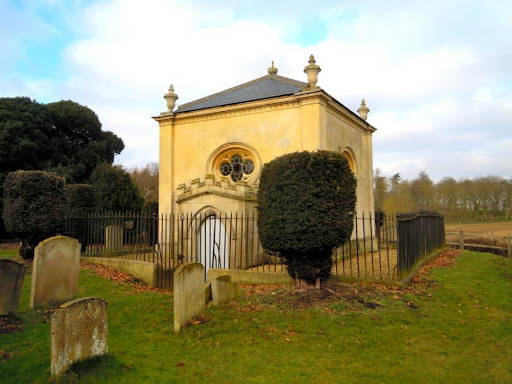Adelaide Magnolia Letter 22 - Mausoleums and Wax Seals
Mausoleums

Ongley Mausoleum. St. Leonard’s Church, Old Warden, Bedfordshire, England. Historic Listed Building.

Milton Mausoleum. Milton, Nottinghamshire, England. Historic Listed Building.
A mausoleum is a grand and imposing structure built to house the remains of the deceased. It showcases exquisite architectural styles and intricate details. Mausolea can range in size and can house anywhere from one individual up to many in separate stone coffins, or sarcophagi. A mausoleum with a single occupant would usually be permanently sealed, while those with multiple occupants would have a door to access the inner burial chamber, which usually was dedicated to the use of a specific family.
Anciently and historically, mausolea were thought to be large and ornate buildings to house and honor the remains of kings or rulers. One example of this is the Taj Mahal in Agra, India, built by the Shah to house his wife’s remains and eventually his own. For centuries the British royals had been interring their deceased loved ones in tombs in what could be classified as a mausolea. Westminster Abbey, an entire cathedral which, to this day, is the final resting place to nearly 3,300 individuals, 18 of which are British monarchs could be considered a mausoleum. With the Abbey as an example, in the 17th century the use of smaller mausolea became popular among those who could afford to bury their dead in style. This usually included nobility and landed gentry.
There are several hundred mausolea in Britain today. They can be found in cemeteries, church yards, or on private estates. Because some of them are hundreds of years old, they have been classified as listed historical buildings and are protected. Though very few from the 1600s are still standing, most of the historical mausolea are from the 17 and 1800s. Most can be visited and viewed and a few are open to the public and can be toured. These monuments are a lasting reminder of not only those who are buried there but of the architecture and the grandeur.
Wax Seals

Sealing Wax on Letters. Photo by Simon A. Eugster. Creative Commons
As many of our Flower Letters subscribers know, getting a letter in the mail is an exciting prospect. But over the centuries, with the advances in science and technology the mechanics of the written letter have changed: the paper used, the writing implements, how they’re delivered, and how the envelopes or letters are sealed. Today, most envelopes are sealed using adhesive, water soluble gum that’s activated by licking or with a wet sponge, or with glue. During the time the Adelaide Magnolia collection takes place, letters were primarily sealed using wax.
The use of wax seals traces all the way back to ancient civilizations in Egypt, China, and Mesopotamia where it can be found on official documents. It wasn’t until the Middle Ages, roughly around 500-100 AD, that the wax seal started to gain more popularity. They were used to authenticate documents, to seal letters (ensuring one could tell if a letter remained unopened), and to also add decoration to documents. Seals were often personal and indicated who the sender was and could be in the form of a stamp that sat on a desk, or formed into jewelry such as a ring or a necklace to be worn.

Signet Ring, Ball Black & Co. 1864. Courtesy of the MET
In Britain, the ruling family are well known for having the Great Seal of the Realm which gives the official seal of the Crown to official documents. It was Edward the Confessor, in the 11th century, who started the practice of using an official seal with an image of his face. This helped to alleviate administrative duties for the King by allowing his seal to be used by another instead of having him to physically sign every document requiring his approval. The practice continues in the royal family to this day. For each new Sovereign, a new seal is created at their request and only one is in use at a time.
The wax used for seals changed over the centuries. Anciently, straight beeswax was used, but in the Middle Ages, resin from trees was added to help harden it and make it stronger. Then colors were added, the most popular being red, which typically came from vermillion cinnabar mineral powder and then from red lead (oxide). Over time the formula continued to change and depended on one’s preference. Some sealing wax was even perfumed with scent. Today, wax is still being used by some who appreciate its ability to add a decorative and artistic touch to their personal correspondence.
Learn the Vernacular:
Sarcophagus: a coffin made of stone, primarily used to display above ground, rather to bury a body.
Sources:
https://en.wikipedia.org/wiki/Mausoleum
https://www.brightwater.group/gb-mausolea/
https://en.wikipedia.org/wiki/Westminster_Abbey
https://www.newworldencyclopedia.org/entry/Mausoleum
https://hankeringforhistory.com/the-history-of-wax-seals/
https://www.royal.uk/great-seal-realm
https://en.wikipedia.org/wiki/Sealing_wax
https://www.fredlake.com/the-rediscovered-art-of-wax-seals
